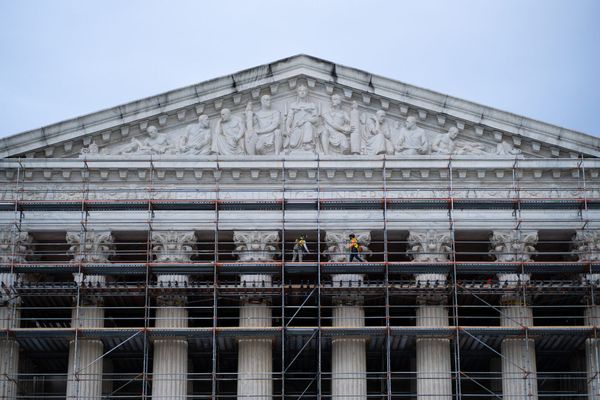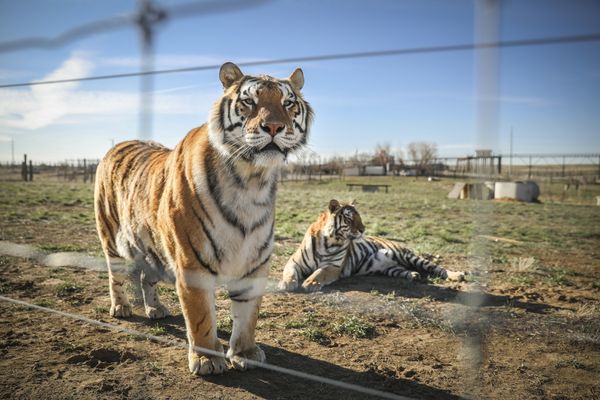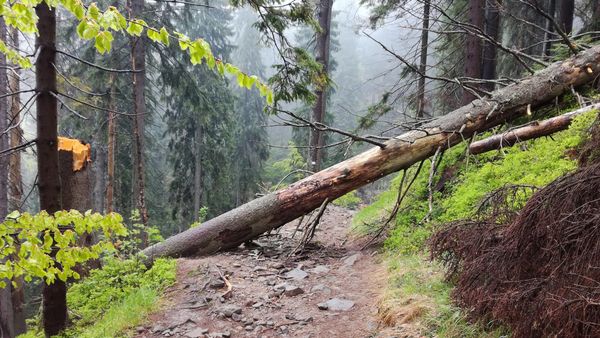
Midsummer on the summit of Arthur’s Seat is just like any other time of year: windy and busy. Come noon on Saturday, all the world is here, it seems, with the strongest representation from the US and Germany, according to my detailed inventory. (OK, eavesdropping.) Groups of young people in inappropriate footwear hold phones aloft, as if they’re at a gig and the main act is Edinburgh and her audacious views. Dogs lift noses to changeable skies and hind legs to rock hewn 342 million years ago by fire and ice. On top of Arthur’s Seat, which Robert Louis Stevenson deemed a hill in size but “a mountain in virtue of its bold design”, it feels equally as though the world is as it ever was, and that everything has changed.


Top: walkers make their way up. Above: students Haya, 23, and Zahra, 22, who travelled from London to see the view
At the height of the pandemic, two years ago, this mythic vantage point was, like everywhere else, vacated overnight; returned to itself. For once, no bristle of ant-like figures on the head of the sleeping lion, as Arthur’s Seat is sometimes described. The emptiness of the extinct volcano where the father of geology, James Hutton, examined an outcrop of veined rock and birthed our knowledge of deep time was unsettling. Every city had its own version of these abrupt changes in perspective, and what they all too briefly revealed about how we were living. Many were not so subtle. In Jalandhar, India, the air pollution cleared and people saw the Himalayan mountains for the first time in 30 years.

Dave from Australia last climbed Arthur’s Seat in 1993. ‘I’m a lot older than I was then,’ he says, ‘but all this looks just the same’
So it means something to be back here for my first walk up Arthur’s Seat in years. Others feel the same. At the top, where great columns of wind seem to carry the northern light as they travel, flattening vast expanses of meadow grasses, I meet a rarity at an elevation of 251 metres: an actual Edinburgher. Sort of. Dave McEwen emigrated to Australia more than 50 years ago, and last climbed up here with his wife and daughters on a visit in 1993. Since his wife died eight years ago, he’s yearned to return. “I’m a lot bloody older than I was then,” he says as we sit side-by-side on north-facing rocks. He sweeps a hand across Leith, East Lothian, the immaculate cone of Berwick Law, and the distant slate shimmer of the North Sea. “But all this looks just the same.”
An hour earlier, I started out opposite Holyrood Palace, built with stone quarried from the park’s cliffs, where the Queen is in residence following the annual garden party. Next to it is the other, younger Holyrood, where Nicola Sturgeon has just announced her bid for a fresh independence referendum. All this in the shadow of a landscape forged by considerably more seismic events at the start of the carboniferous period. Basically, if you’re looking for an earthly expression of the phrase about everything changing and everything staying the same, this is it. As if on cue, a gleaming white coach pulls into the car park and a stream of pipers in full tartan regalia disembark and disappear into the palace grounds.



Top: a detail of a climber’s hands at the summit. Above left: a woman poses for a photograph. Above right: Radhika Guruju, Srividya Bharath and Reshmi Lisitza, who say they are off to ‘search for Camelot’
I watch this Scottish spectacle with a trio of Indian women; two from the US, one from Singapore. They’re off to “search for Camelot”, says Radhika Guruju, referring to the (oft-disputed) legend encircling the hill. So far their journey through the land of Arthurian legend has been one of delays and cancellations. Despite coming for a fortnight, they travelled with hand luggage because they were scared to check in their bags.
Of course, we now know that everything does not stay the same. The Radical Road route up Arthur’s Seat passing the rock that led Hutton to burst the boundaries of time has been closed for years due to a high risk of rockfall “accelerated by long-term change in weather conditions”. Which is a polite Edinburgh euphemism for “climate emergency”. I take the classic route, walking with the hungover, tourists bumping pull-along cases through the scree, joggers, and parents coaxing (and eventually carrying) children. I meet people from Chicago, Montana, San Francisco, Barcelona, Cambridgeshire, Ireland, and a group of Scouts from Belgium who camped here overnight, which is not allowed but I haven’t got the heart to tell them. Apparently it was “windy, dark and rainy” and they saw “a frog, a big bird that might have been a gull, and three dogs”.

Edinburgher Robert with his dog, Alfie
No matter how often one does it, it’s an astonishing ascent: swift, steep, instantly gratifying. The gorse isn’t blooming but appreciation – a perspective born out of the freedom that follows restriction, loss, fear, and isolation – honeys the air. Near the summit I meet Robert Dunn (another lesser-spotted local) and his 12-year-old border terrier, Alfie. They climb Arthur’s Seat every day. “Whichever hill we’re on, they come,” explains Dunn, gesturing towards the murder of crows gathering as we talk. Meanwhile, a queue of international strangers forms by Alfie, who is the kind of deeply charismatic dog everyone wants to stroke. “We don’t go fast now,” Dunn concedes as Alfie trundles off to park his bottom against another admirer’s legs. “We’ll always stop for a wee rest, and we talk to everyone. Oh, he loves it here.”

A well-earned reward at the end of the descent







